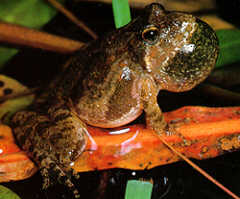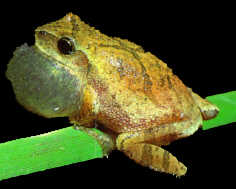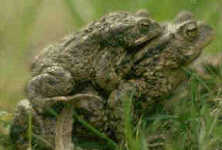
Frog courtship is really something. If you've had your
pond more than one year, I'm sure you're aware of that! Besides
what you hear, there's a lot more going on! It goes like this: one
frog may rise suddenly on all fours and begin to quiver. The
males quiver in fevered spasms during courtship when their
calling is most frantic. Two or more males may face one another,
shaking all over; one frog may grab another and pin him flat
against a leaf. These visual signals are relatively uncommon
among frogs, since they are primarily nocturnal and usually
communicate by sound. This quivering posture is used to claim
territories and/or to hopefully intimidate rival male frogs while
advertising their strength. Meanwhile other male frogs gather
around in shallow water, inflating their vocal sacs as


Most female frogs, unlike humans, are larger than the males.
They slowly approach the pond in a crawling motion, hoping not
to attract too much attention. But once they are noticed, then
several males may clasp her at the same time, wrestling for an
advantageous position until one locks himself into the mating
position astride her back, clamping his arms and legs around her
stomach. This embrace is  called amplexus. Amplexus can last several days!
On occasion, two or three males will cling to a single female,
waiting for her to find a suitable spot for egg laying before they
all attempt to fertilize the eggs. If the female doesn't lay eggs on
the first night, she will sleep with the male on her back until the
following evening. Maybe you've seen them in this piggyback
position.
called amplexus. Amplexus can last several days!
On occasion, two or three males will cling to a single female,
waiting for her to find a suitable spot for egg laying before they
all attempt to fertilize the eggs. If the female doesn't lay eggs on
the first night, she will sleep with the male on her back until the
following evening. Maybe you've seen them in this piggyback
position.
In most cases this complicated courting behavior occurs, but
many species of frogs are known for attempting to mate with
anything that moves which isn't small enough to eat!
Next comes egg laying. Most species of frogs lay their eggs
directly in water, often in our ponds, or even near-by roadside
ditches. The female frogs must fill her bladder after laying each
batch of eggs or their eggs will dry up.
While in the amplexus position, the male frog fertilizes the
 eggs as they get laid. Frogs
tend to lay single eggs in masses, whereas toads usually lay eggs
in long chains. Frogs and toads tend to lay many many eggs
because there are many hazards between fertilization and full
grown frogness!
Some frogs leave after the eggs are laid, but others stick around
to watch over the little ones. Some have very unusual ways of
caring for their young. But that would be another whole article!
eggs as they get laid. Frogs
tend to lay single eggs in masses, whereas toads usually lay eggs
in long chains. Frogs and toads tend to lay many many eggs
because there are many hazards between fertilization and full
grown frogness!
Some frogs leave after the eggs are laid, but others stick around
to watch over the little ones. Some have very unusual ways of
caring for their young. But that would be another whole article!

At Dorota's Life Cycle of a Frog site, you can find out more than you perhaps have ever wanted to know about frog sex! Other information for this article was gleaned at the Discovery Channel's great site Froggy Went A-Courtin'!